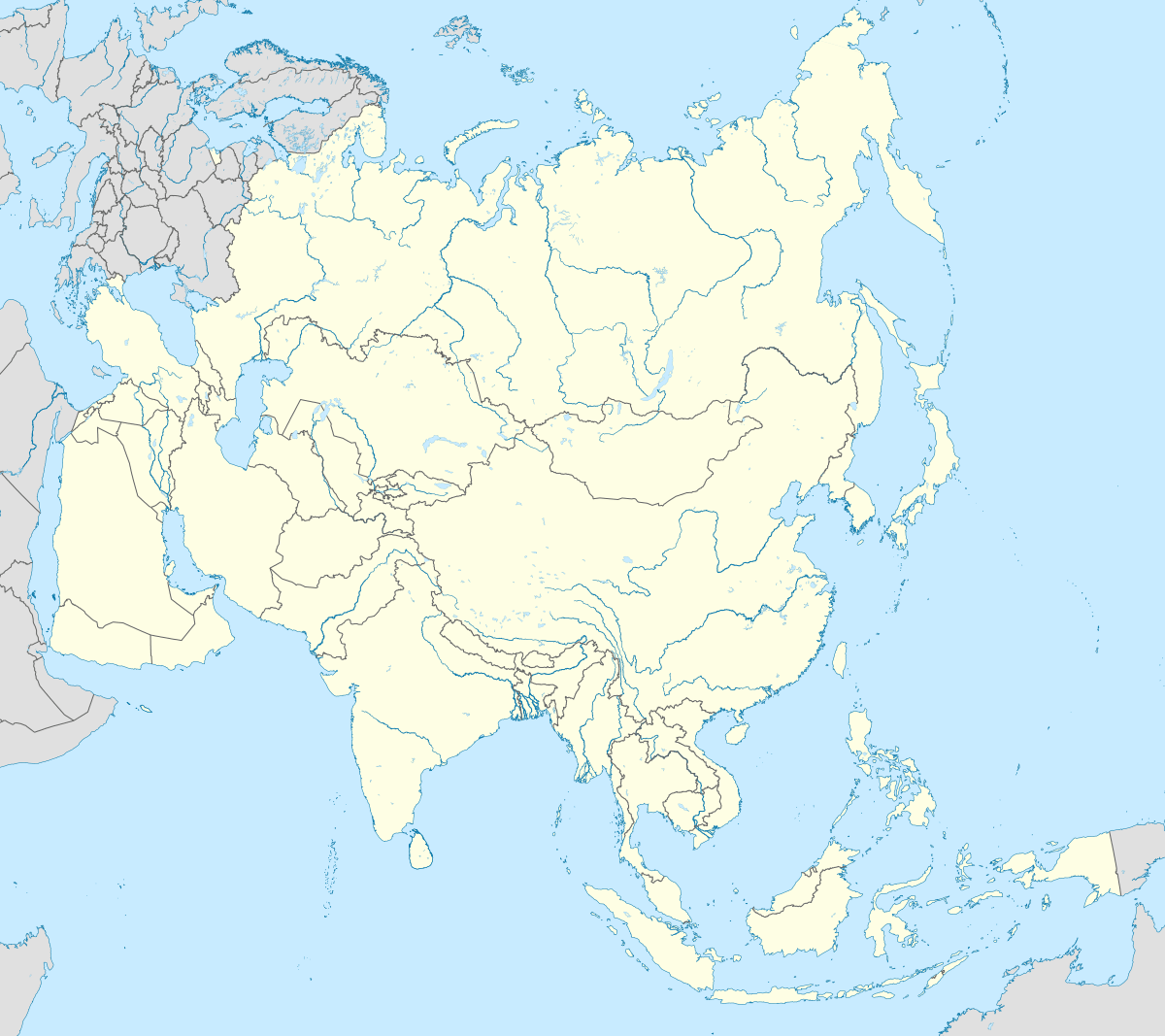Seletar Airport
Seletar Airport (IATA: XSP, ICAO: WSSL) is a commercial airport serving the north-east region of Singapore. It is approximately 16 kilometres (9.9 mi) away from Singapore Changi Airport and about 20 kilometres (12 mi) away from the city-centre.
Seletar Airport Lapangan Terbang Seletar 实里达机场 செலட்டர் வான்முகம் | |||||||||||
|---|---|---|---|---|---|---|---|---|---|---|---|
 | |||||||||||
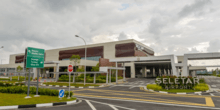 | |||||||||||
| Summary | |||||||||||
| Airport type | Civilian public usage | ||||||||||
| Owner | Government of Singapore | ||||||||||
| Operator | Changi Airport Group | ||||||||||
| Serves | Singapore | ||||||||||
| Location | 21 Seletar Aerospace Road 1, Singapore 797405 | ||||||||||
| Elevation AMSL | 11 m / 36 ft | ||||||||||
| Coordinates | 01°25′01″N 103°52′04″E | ||||||||||
| Website | www | ||||||||||
| Maps | |||||||||||
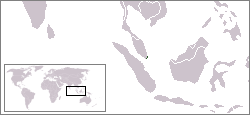 | |||||||||||
| Runways | |||||||||||
| |||||||||||
The airfield was originally opened in 1928 as RAF Seletar, a military airbase of the British Royal Air Force. The base was handed back over to the Singapore government in 1971.
History
RAF Seletar
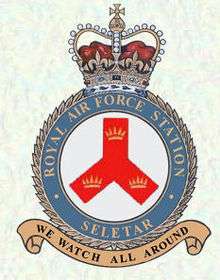
RAF Seletar was a Royal Air Force station in Singapore between 1928 and 1971. Plans for establishing an airfield, flying boat and naval base in Singapore were first agreed by the RAF in 1921. In 1923, two sites in the northern region of the island were approved. The first planes to arrive at the base were four Supermarine Southampton seaplanes on 28 February 1928.
RAF Seletar served was also used for civilian flights from 1930 to 1937, when Kallang Airport was opened.
Amy Johnson landed at Seletar in May 1930 on her UK – Australia flight in her Gipsy Moth named 'Jason'. Amelia Earhart also landed there in June 1937 on her world flight attempt in an Lockheed 10 Electra.
World War II
With the threat of war in the area, the RAF started building up their forces in the Far East in the late 1930s and early 1940s. Seletar airfield was the target of carpet bombing when Japanese navy bombers conducted the first air raid on Singapore, sometime after their ground forces invaded Kota Bahru. It was abandoned when the Japanese took Johor Bahru, which brought their artillery in range of the airfield.
When the Japanese launched their invasion of Malaya and Singapore, Seletar housed four RAF units. 205 Sqn operated Consolidated Catalina flying boats, and No. 36 and No. 100 Squadron RAF operated obsolete Vickers Vildebeest torpedo bombers (as well as five Fairey Albacores acquired by 36 Sqn to supplement its Vildebeests). These flying squadrons were serviced by 151 Maintenance Unit RAF.
21 Squadron, Royal Australian Air Force was also based at Seletar in 1941–42, and was in the process of converting from lightly-armed CAC Wirraway trainers to Brewster F2A Buffalo fighters, when hostilities began.
These units stayed until Jan–Feb 1942, soon before the surrender to the invading Japanese.[1]
During the Japanese occupation, Seletar as was in the case of Sembawang came under the Imperial Japanese Navy Air Service while Tengah fell under the jurisdiction of the Imperial Japanese Army Air Force. From 1942 through 1945, a number of IJN squadrons were based or transited through Seletar mainly, for training. Among the units known to be based at Seletar during this time were 936th Kōkūtai (B5N Kate, D3A Val and E13A1 Jake), 381st Kōkūtai (A6M Zero and J2M Raiden). The 601st Kōkūtai was also stationed there for training early before its destruction on board Japanese aircraft carriers during the Battle of the Philippine Sea (Marianas Turkey Shoot) in June. Seletar's present runway was built during the Japanese Occupation.
Post-World War II
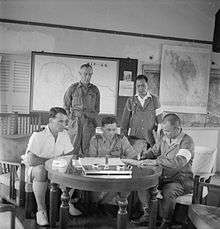
After World War II, the base went back to the RAF and, in the late 1940s and 1950s, the base was heavily involved in the Malayan Emergency, with Beaufighters, Spitfires and Mosquitos based there while operating against Malayan Communist insurgents. Among the many squadrons based there during this time were Nos 60, 81 and 205 Sqns of the RAF.[2] The base was also the home of 390 MU – the Maintenance Base for the whole of the Far East Air Force - FEAF.
During the 1960s, RAF Seletar was home base to No's 103 and 110 Squadrons, both of which were equipped with Westland Whirlwind Mk 10 helicopters and to 34 Squadron, which was equipped with Blackburn Beverley transports. All three Squadrons (among several others) were involved with support of operations in North Borneo during the Indonesia-Malaysia confrontation. From June 1962, 66 Squadron (led by Sqn Leader Gray) with their Bristol 192 Belvedere helicopters were also based at Seletar, and were sent on frequent tours and detachments to Kuching, Brunei, Labuan and Butterworth as part of the Borneo hearts and minds campaign (the squadron was later disbanded in March 1969).[2] The helicopter squadrons provided a search and rescue service for the Singapore area. The station was also, at that time, home to 209 Squadron, equipped with Single and Twin Pioneer aircraft. 65 Squadron based at Seletar operated Bloodhound Mk II surface-to-air missiles as anti-aircraft defence from 1 January 1964 until the squadron was disbanded on 30 March 1970 with the equipment and role handed over to 170 Squadron, Republic of Singapore Air Force.[2] Auster aircraft were flown during the Emergency and Confrontation periods in troop/enemy spotting patrols.
In December 1966, three Andover CC Mk1 arrived to replace the ageing Vickers Valetta C1 aircraft of 52 Sqn. 52 Squadron was later reformed in March 1967 after the arrival of a further three aircraft. By now, Confrontation had finished and with no purpose the squadron moved to Changi in 1968 before being disbanded in January 1970.[2]
British Pullout
The RAF station closed at the end of March 1971 (see East of Suez) and Seletar was handed over to the Singapore Air Defence Command (SADC), which by 1973, after the British pullout, became the Republic of Singapore Air Force (RSAF).
Several classic aircraft types flew their last RAF operational sorties from Seletar including the Short Singapore flying boat (Mk.III K6912 of No. 205 Squadron RAF 14 October 1941, aircraft transferred to No. 5 Squadron RNZAF),[3] Supermarine Spitfire (PR.XIX PS888 of 81 Sqn 1954), De Havilland Mosquito (PR.34 RG314 of 81 Sqn 1955), Short Sunderland flying boat (GR.5 ML797 "P" of 205 Sqn, 15 May 1959) and Bristol Beaufighter (TT.X RD761 Station Flight 1960). The Short Sunderland flying boats started in RAF service from Seletar on 22 June 1938 with 230 Sqn,[4] a sister squadron of 205 Sqn.
Seletar Airbase
The formative years of the SADC (later the RSAF) was established at Seletar Airbase in September 1968, with the setting up of the Flying Training School (FTS) utilising three Cessna 172G/H on loan from the Singapore Flying Club. The subsequent arrival of eight new Cessna 172Ks in May 1969, took over the duty from the former and contributed to the increase of training tempo for more selected trainees to participate in the basic flight-training course.
Current operations
Seletar Airport now operates as a general aviation airport, mainly for chartered flights, private aircraft operations and training purposes. The airport is open 24 hours a day. It has a single runway with 27 aircraft stands, 100 square metres of warehouse space and can handle 840 tons of freight per day. In 1998, the airport recorded receiving a total of 7,945 scheduled flights, handled 23,919 passengers and 6,025 tons of cargo.
The airport fire service, AES Seletar, is provided by Changi Airport Group. AES Seletar has 1 station housing 6 apparatus (water tender, foam tender and others) and provides Level 7 protection.[5]
The Republic of Singapore Flying Club, Seletar Flying Club and Singapore Flying College are situated at Seletar Airport. The Singapore Flying College also conducts its flying training at Jandakot Airport in Perth, Western Australia and at Sunshine Coast Airport in Maroochydore, Queensland. Another prominent flying school is the Singapore Youth Flying Club, which has its headquarters built on western side of the airport's runway. Completed in June 2003, the clubhouse also has its own parking bays for its fleet of Diamond DA40. Also, the rotary training unit of Republic of Singapore Air Force – 124 Squadron, has a training detachment at the civilian airport although it is normally headquartered at Sembawang Air Base.
Previously, Berjaya Air operated scheduled flights to Tioman and Redang. The Berjaya Air service ended on 31 October 2010 and relocated to Changi Airport.
Expansion
Changi Airport Group took over the management of the airport from the Civil Aviation Authority of Singapore on 1 July 2009.[6] In 2011 the runway was extended to 1,840 metres to enable larger and heavier aircraft to use the airport.[7]
The airport underwent refurbishment in 2015 as part of plans to relieve pressure on Changi Airport. The plan was to optimise its capacity and move smaller and slower aircraft from Changi to Seletar airport.[8]
A new passenger terminal building opened on 19 November 2018, replacing the previous passenger terminal.[9] The terminal houses four check-in counters, six immigration lanes, two security screening stations and a gate holdroom that can accommodate 200 passengers.[10][11][12]
Instrument Landing System (ILS) Controversy With Malaysia
Malaysia banned its airline Firefly, one of two subsidiaries of state-owned Malaysia Airlines from using Seletar airport after the relocation of its ATR 72 turboprop aircraft from Changi Airport in Singapore, which was due to commence operation on 1 December 2018. Changi has phased out the use of turboprop aircraft and Singapore has designated Seletar as the airport for turboprop operation. The ban was imposed on Firefly after Singapore published the Seletar's Aeronautical Information Publication for the Instrument landing system on 1 December 2018 that covers Johor airspace over Pasir Gudang, an act which Malaysia claimed violated its sovereign territory. The ban impacted the flight operation plans of two other Malaysian-based airlines, Berjaya Air and Malindo Air which also planned to commence operations between Seletar and Malaysian destinations in 2019.
Installation of an ILS for Seletar Airport
As early as January 2012, the Civil Aviation Authority of Singapore (CAAS) had indicated that an ILS will be installed at Seletar Airport by 2014 as part of the upgrading work for the airport, which had commenced expansion and improvement works since 2008.[13] In 2014, Singapore had formally informed the then Department of Civil Aviation Malaysia, currently known as the Civil Aviation Authority of Malaysia (CAAM), that all turboprop aircraft, private jets and chartered aircraft from Changi Airport will be relocated to Seletar Airport by end-2018.[14]
Changi Airport Group, (CAG) the airport operator for Changi and Seletar, said that it had been working with Firefly since 2014 to prepare for Firefly's shift to Seletar airport, as part of a plan to move all turboprop aircraft movements out of Changi airport and that Singapore has made all preparations and approved all applications by Firefly to commence scheduled turboprop operations at Seletar airport from 1 December 2018, without affecting operational efficiency or flight safety.[15]
In July 2017, Ignatius Ong Ming Choy[16] CEO of Firefly, a subsidiary of Malaysia Airlines (MAS) and a respected member in the aviation community, had raised the issue of an ILS which has not been in installed in Seletar, to the Singapore civil aviation authority, in which Firefly believed that the lack of an ILS impacted on Seletar airport's aim to be "a proper commercial airport" as the ILS will improve aviation safety and enhance operational efficiency of descending aircraft into the airport during poor weather, night landing or adverse visibility.[17][18][19] Ignatius Ong had represented Malaysia Airlines in Kuala Lumpur and Beijing as a leading member of the responsive MAS crisis management team that dealt directly with traumatised relatives of those in the missing Malaysia Airlines Flight 370.[20][21][22][23]
Consultation Meetings on ILS and Firefly's Move to Seletar
By end-2017, a draft ILS procedure for descending aircraft into Seletar airport for Runway 03 and Runway 21 had been presented by CAAS to the Department of Civil Aviation Malaysia also known as the Civil Aviation Authority of Malaysia (CAAM) for consultations and feedback. Singapore needed CAAM's input for the ILS installation in Seletar as the ILS will covers Malaysian airspace over Pasir Gudang, which was delegated to Singapore in 1973 by Malaysia, with the approval of the International Civil Aviation Organization (ICAO).
On 5 December 2017, in a meeting in Kuala Lumpur between the civil aviation authorities of Malaysia and Singapore, the draft ILS operational procedures for Seletar airport was further discussed, and the draft Instrument Approach charts and overview maps showing the full details of the incoming descending approach and missed approach procedures for Seletar Airport ILS were presented by CAAS to the Malaysian authorities.[24]
In that meeting, CAAS informed CAAM that, to facilitate the move of turboprop operators like Firefly to Seletar by end-2018 and improve the safety and operational efficiency of aircraft operations, Singapore intended to install an ILS at Seletar between December 2017 and February 2018 with an Airport Instrument Approach (AIP) Supplement charts to be published by 31 May 2018 and made effective by 16 August 2018. Further as the Seletar ILS will cover part of the Malaysian airspace over Pasir Gudang that was delegated to Singapore, CAAS informed CAAM in that meeting that Singapore "would send DCA Malaysia the draft charts and details as part of the formal consultative process to enable the publications of the (ILS) procedures."
0n 6 December 2017, CAAS sent an email to CAAM, together with the all the draft charts and details, and further informed that should Malaysia requires more information about the ILS or wishes to highlights any concern about the system, the CAAS would be ready to address all technical issues.
Since there was no response for six months from Malaysia until 6 June 2018 (which by then was already past the CAAS's intended publication date for the ILS-AIPs on 31 May 2018) Singapore sent another email to Malaysia requesting for an update on the ILS issue, as CAAS intended to publish the ILS-AIP data on the revised date of 7 June 2018.
On 7 August 2018, the two civil aviation authorities met in Kuala Lumpur where CAAS provided additional details on the Seletar ILS procedures, and Singapore requested from Malaysia for its urgent feedback on the ILS.
On 15 August 2018 15, CAAS sent to CAAM another email stressing the urgency of Malaysia's feedback on the ILS matter due to the impending move by Firefly to Seletar on 1 December 2018, and Singapore requested CAAM's prompt response by 27 August 2018, but there was no reply from CAAM to the Singapore requests.
At the sidelines of an International Civil Aviation Organization event soon after, Singapore continued to engage with Malaysia for an update on the ILS issue, without success.[25]
On 14 November 2018, Firefly informed CAAS that it was "unable to obtain approval from its regulator, CAAM, to operate into Seletar airport".[26]
Suspension of Firefly's Malaysia-Singapore operations
In an announcement on 22 November 2018, Firefly announced on its website that it will suspend all of its 10 daily flights between Singapore and the three Malaysian towns of Subang, Kuantan and Ipoh from 1 December 2018, until "the relevant authorities have cleared remaining matters in relation to the Singapore authority's plans to move turboprop operations from Changi International to Seletar (Airport)”. The Firefly announcement was described as "rather unusual " by Brendan Sobie, the Southeast Asia chief representative for the Centre for Aviation (CAPA).[19][27][28]
The suspension resulted in more than 12,000 Firefly customers adversely affected and many were transferred to Malaysian Airlines (MAS), Firefly's parent company, thus incurring considerable losses to both airlines and causing negative impacts on the aviation sectors on both Malaysia and Singapore. Firefly could not obtained its landing slots to Changi airport since those slots were already sold to other non-turboprop operators.
Firefly's intended move was thus vetoed by Malaysia which had said that the move will be detrimental to the development of Malaysian interests in Pasir Gudang, Johor and that the flight path had intruded into Malaysian airspace and therefore violated Malaysian sovereignty and development of its international port.[29][30]
On 23 November 2018, Malaysia declared in a media statement that Singapore had never discussed an ILS for Seletar Airport with CAAM and Malaysia "was never consulted (by Singapore) on the timeline to move scheduled turboprop operations to Seletar Airport starting Dec 1, 2018".[31][32]
CAAM's Airport Standard Division director Dr Zainul Fuad Md Wahi[33][34] in a press conference stated that CAAM did not receive any communication from Singapore about the ILS and that the "requirement (to fly over Pasir Gudang) was never communicated to CAAM, and CAAM had never made any indication that CAAM agreed with it, especially when taking into consideration that it would affect the development over Pasir Gudang and its international port".
Zainul Fuad Md Wahi added that the Seletar ILS issue surfaced only when Firefly was asked to move its flights from Changi Airport to Seletar by 1 December 2018.
On Thursday 29 November 2018, both civil aviation bodies met in Singapore where CAAM raised its technical concerns with the Seletar ILS procedures, which were promptly addressed by CAAS during that meeting.
Singapore again conveyed to Malaysia of its intentions to publish the long-delayed ILS and AIP procedures on 1 December 2018, seven months later than the originally planned for 31 May 2018.
On Friday 30 November 2018 and with Firefly's scheduled move to Seletar to be conducted less than one day away on 1 December 2018, CAAS team flew to Kuala Lumpur to meet CAAM to discuss the records of the 29 Nov meeting, including whether there was any new issue on the ILS or other matters, as well as to facilitate Firefly operations (which had been suspended) between Malaysia and Singapore from 1 December 2018 onwards.
During that meeting, Malaysia did not raised any new concern to Singapore regarding the ILS, airspace sovereignty or other new issues, and the records of discussion during the two meetings on the 29 and 30 November 2018 by the two sides were minuted, including Singapore's intention to publish the ILS-AIP data on the next day, 1 December 2018, to facilitate Firefly relocation to Seletar airport from Changi airport.[25]
Publication of the Aeronautical Information Publication
On 1 December 2018, CAAS officially published the AIP Supplement AIP SUP 079/2018-1 AIP Singapore for the implementation of ILS and Approach Procedure for Seletar Runway 21[35] which shall be effective as at 3 January 2019 and informed all stakeholders, including CAAM, Firefly and the International Civil Aviation Organization (ICAO) in Montreal, Canada, thus clearing the way from the Singapore side for Firefly to commence commercial flight operations between Subang-Seletar, Ipoh-Seletar and Kuantan-Seletar operations.[36] in the event Firefly managed to obtain the approval from CAAM to do so.
Firefly, being the sole turboprop operator to Changi Airport and already with the much-coveted landing slots and firm schedules to Seletar Airport would have been the biggest commercial flight operator into Seletar airport as others like Berjaya Air, Malindo Air, Wings Air, City Link have not been as prepared as Firefly, with Berjaya Air expected to fly to Seletar later in February 2019 together with Malindo Air[37][38][39][40][41][42]
Objections in Malaysian Parliament
Addressing the Malaysian Parliament on Monday, 3 December 2018, the transport minister Anthony Loke Siew Fook said that Singapore's ILS proposal had violated Malaysian sovereignty by publishing the ILS-AIP procedures for Seletar Airport on 1 December 2018 without CAAM's approval, and the Malaysia's Ministry of Foreign Affairs will send a statement of protest to Singapore over the territorial violation caused by Singapore's publication of the ILS procedures.[43]
Loke added that Malaysia was informed by Singapore only around October 2018 of Singapore's intent to commence ILS operations for Seletar airport.[44] and that during the meetings on 28 and 29 Nov between the two national aviation bodies of Malaysia and Singapore, CAAM had conveyed to Singapore not to allow CAAS to broadcast its ILS, which Singapore ignored and proceeded to broadcast the ILS from 3 January 2018.
In the parliamentary speech, Loke said that Malaysia had informed Singapore that it would be taking back its delegated airspace between 2019 and 2023, which was delegated to Singapore in 1974 under the Operational Letter of Agreement between Kuala Lumpur and Singapore Area Control Centers Concerning Singapore Arrivals, Departures And Overflight (LOA 1974).[45]
Within hours of Loke's statements, Singapore released a minutes of meeting dated 5 December 2017 and email correspondences dated 6 December 2017 and 17 June 2018 between CAAS and CAAM to counter Loke's claims that Malaysia was informed about the ILS only around October 2018 as well as to counter CAAM's Zainul Fuad Md Wahi's statement that CAAM was never informed by CAAS about an ILS for Seletar airport.[46][47]
Reacting to Singapore's releases of the correspondences, Loke said on 10 December 2018 that Singapore was being partial and selective in the choice of correspondences it published and he challenged Singapore to release four other letters dated 9 October 2018, 15, 21 and 28 November 2018 which Singapore failed to do so.
Malaysia further feedback to Singapore that "failing to do so, we (Malaysia) are prepared to release the letters for full disclosure of such information for the public's comprehension of our stand on the same."[48][49][50]
On the same day (10 December 2018) Singapore informed Malaysia that Singapore had no objections for Malaysia to proceed and release all the letters, email correspondences and records of discussions on the ILS between CAAM and CAAS, but not limited to just the four letters as mentioned earlier by Malaysia, but to include all correspondences and minutes of discussions for total transparency regarding the CAAM-CAAS negotiations on the Seletar airport's ILS unit.[51][52]
After Singapore announced that it had no objections to Malaysia's threatened release of the CAAM-CAAS letters, Malaysia announced on 12 December 2018 that it declined to release any correspondence on the Seletar ILS citing the need for confidentiality. Malaysian Transport Ministry said that it is a "matter of principle not to release correspondence between parties to address media queries and get public support and it agreed with its Singaporean counterpart that it would be useful for negotiations to be kept confidential to facilitate frank and constructive exchanges."[53][54]
Issues Raised Between Malaysia and Singapore
Violation of Malaysian Sovereignty
That video showed that since the south-bound flight path to Seletar airport overflew Pasir Gudang, the ILS operations violated Malaysia territorial rights.
The airspace over Johor delegated to Singapore in 1974 under the Operational Letter of Agreement between Kuala Lumpur and Singapore Area Control Centers Concerning Singapore Arrivals, Departures And Overflight (LOA 1974) and CAAS was of the view that airspace sovereignty and ILS operational procedures are separate issues, since Singapore had never denied that the airspace over Pasir Gudang is Malaysian territory.
It was pointed out that Malaysian air traffic controls had similarly overlapped the national territories of Brunei, Indonesia and Thailand, where Brunei's upper airspace is managed by Malaysia under the Kota Kinabalu Flight Information Region, which also covers the Indonesian waters around Kuching Airport, which is outside Malaysian territory[55]
Changi Airport similarly has ILSs that extended into Johor in southern Malaysia and over Batam Island in the Riau region of Indonesia while the Singapore Flight Information Region extended northwards to the Malaysia-Thailand border and into the territorial waters of Vietnam and eastwards towards the Philippines Sea.
Kota Kinabalu FIR covers Brunei northern airspace as well as the airspace over Indonesia territorial waters near Kuching Airport.[56] Indonesia managed the airspace over Australia's Christmas Island and Timor Leste.[57][58][59] while in Europe for example, Denmark managed airspaces over Sweden and Scotland.[60]
ILS Imposed Compulsory Height Restrictions
In his Facebook video post dated 11 December 2018, Loke claimed that the ILS in Seletar will impact Pasir Gudang sea port developments and will place compulsory height restrictions on the port and developments in Pasir Gudang and further north all the way northwards to the towns of Air Tawar and the outskirts of Kota Tinggi, about 25 km north of Seletar.[30][61] Loke added that Singapore should installed the ILS facing south of Seletar for Runway 03 instead of facing north towards Malaysia, for Runway 21 at Seletar airport.
On 13 December 2018 Singapore denied that the Seletar ILS placed compulsory height restrictions in Pasir Gudang and that Malaysia sovereignty over Pasir Gudang airspace was never questioned by Singapore, being the party delegated by Malaysia to manage that airspace since 1973 and agreed by both countries and approved by the ICAO. Singapore also stated that based on historical meteorological patterns, the Seletar and Pasir Gudang regions faced opposing wind directions for each half of a year, thus singular directional approach and take-off procedures via Seletar's Runway 03 only will render flight operations unsafe.[62]
Numerous experts have since pointed out that with the ILS in place, it will help the pilots to land properly and safely and will not impose any compulsory height restrictions.[63]
In that video[61] Loke Siew Fook had stated that at 3,000m from Seletar airport, there is a height restriction of 54m compulsorily enforced by the ILS on building heights in Pasir Gudang, while at 6,000m the height restriction is 145m, where ""this means, even a mobile crane would have breached the height limit and there are many tall buildings in Johor".[64][65]
On 12 December 2018, Singapore countered by stating that at 3,000m from Seletar airport, the bare height limit, without a safety buffer zone, is 93.8m while at 6,000m, it is 193.1m, while at a 25 km mark from Seletar, at Air Tawar or Kota Tinggi, the height limit exceeds 1,000m high.[66] Since the ILS has a safety buffer zone, the height at 3,000m from Seletar airport is 2005m, while at 6,000m it will be 401m, and at Air Tawar and Kota Tinggi, the height will be 1,066.8m or about 200m higher than the height of Burj Khalifa in Dubai at 829.8m or more than twice higher than the Petronas Twin Towers at 452m.
Singapore explained that a descending plane approaching Seletar Runway 21 at a 3.5-degree glide slope will be at a height of 183.5m at 3,000m from Seletar and 366m high at the 6,000m mark while at 25 km away in the Air Tawar and Kota Tinggi region, incoming aircraft into Seletar airport will be at a minimum height of 1,066.8m or 3,500 feet.[67]
With a safety buffer zone under the ILS glide path, the height of a descending aircraft at the 3,000m mark from Seletar is increased to 200.1m which is the same height before the ILS comes into operation on 3 January 2019, and that the glide path and height limits are in accordance with safety and operational standards required by the International Civil Aviation Organization (ICAO)[66] which both Malaysia and Singapore had ratified.
Singapore said that all existing tall buildings directly below the current Seletar glide path have been taken into account in the design of the ILS procedures and that the Singapore authorities have not been informed of any new developments being planned in Pasir Gudang that could significantly affect the flight profile for Seletar flights. Malaysia have not obligation to inform any future developments in Pasir Gudang to Singapore as these do not affect any Singapore sovereignty.
The current Seletar airport glide path over Pasir Gudang passes over the Johor Port Pasir Gudang Container Terminal where eight gantry cranes, each exceeding 90m high or equivalent to a 30-storey building, are in operation and it also passes over the TNB Sultan Iskandar Power Station with a smoke chimney exceeding 125m. Both the cranes and the chimney (completed in 1980) are located on the Pasir Gudang shorelines of the Johor Straits and located directly north of Seletar Airport under the glide path and these tall structures are clearly indicated in the Seletar Aeronautical Information Publication (AIP) and Instrument landing system (ILS) charts published by CAAS on 1 December 2018 as well as in the Visual approach charts for Seletar airport.[68]
Under ICAO regulations, countries with adjacent air boundaries are required to provide early notification of proposed future developments to all relevant parties so that flight procedures can be adjusted if necessary and Singapore will make operational adjustments for any future development plans involving tall buildings in Pasir Gudang and all affected areas under the ILS glide path into Seletar.
Higher Risk For Pasir Gudang
Singapore assured Malaysia that for more than three decades, the republic has safely managed flight operations and ships transiting the Johor Strait to and from ports and marine facilities in Pasir Gudang region and in this regard, Singapore had installed the Vessel Height Measuring System (VHMS) to safeguard both aviation and maritime activities which, and on occasions, had flights been delayed while tall vessels crossed the Strait of Johor safely.[66]
The VHMS protocol had been in operation since 1986 and was also presented by the CAAS to the ICAO on 17 August 2011.[69][70] Singapore further stated that the Seletar ILS procedure is meant to enhance the safety of the existing flight operations over Pasir Gudang and it does not create a new flight path that differs or deviates from the current air corridor that had been in operations since 1974.
Other Airlines Affected: Berjaya Air And Malindo Air
Besides Firefly, two other airlines, Berjaya Air and Malindo Air, are not expected to start their Malaysia-Seletar routes until both airlines had received permission from the Civil Aviation Authority of Malaysia to use Seletar airport.[71]
On 14 December 2018, Malaysia said that enough had been said publicly and that technical and aviation experts from both sides should be given space to solve any technical issues, hence Malaysia requested for bilateral meeting promptly with Singapore.[72]
Pasir Gudang Airspace Declared As Restricted Military Area
On 25 December 2018, Malaysia declared that the air space over Pasir Gudang is a restricted area for the purpose of military activities which shall go into effect on 2 January 2019. CAAM had published a Notice to Airmen (NOTAM) on 25 December 2018 that informed the aviation community of its establishment of a permanent restricted area.
Singapore Ministry of Transport said the restricted area, being within a controlled and congested airspace, will impact the existing and normal operations of aircraft transiting through the airspace.[73][74]
Airlines and destinations
| Airlines | Destinations |
|---|---|
| EastIndo | Charter: Jakarta |
| Firefly | Kuala Lumpur–Subang[75][76] |
Photo gallery
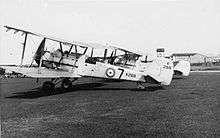 Vickers Vildebeest Mk IIs, K2918 and K2921, of 'A' Flight, No. 100 (TB) Squadron, at RAF Seletar.
Vickers Vildebeest Mk IIs, K2918 and K2921, of 'A' Flight, No. 100 (TB) Squadron, at RAF Seletar.
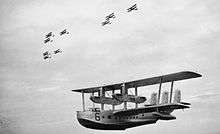 Short Singapore Mk III flying boat of 205 Sqn, in flight below three 'vic' formations of Vickers Vildebeest torpedo bombers of 100 Sqn.
Short Singapore Mk III flying boat of 205 Sqn, in flight below three 'vic' formations of Vickers Vildebeest torpedo bombers of 100 Sqn.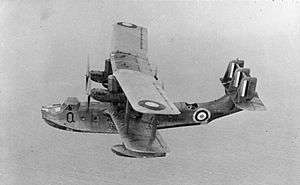 A Short Singapore Mk III flying boat, similar to those operated by 205 Sqn.
A Short Singapore Mk III flying boat, similar to those operated by 205 Sqn.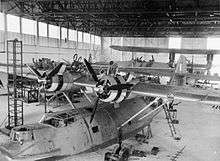 Catalina I of 205 Sqn undergoing servicing in their hangar at RAF Seletar. One of the squadron's Short Singapore Mk III biplane flying boats can be seen in the right background.
Catalina I of 205 Sqn undergoing servicing in their hangar at RAF Seletar. One of the squadron's Short Singapore Mk III biplane flying boats can be seen in the right background. December 1945, captured Mitsubishi J2M Raiden fighters belonging to the 381st Kōkūtai of Imperial Japanese Navy Air Service being evaluated at Seletar airfield.
December 1945, captured Mitsubishi J2M Raiden fighters belonging to the 381st Kōkūtai of Imperial Japanese Navy Air Service being evaluated at Seletar airfield.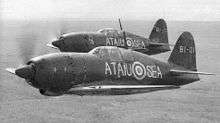 The same Mitsubishi J2M Raiden fighters being test flown by Japanese naval aviators under close supervision of RAF officers from Seletar.
The same Mitsubishi J2M Raiden fighters being test flown by Japanese naval aviators under close supervision of RAF officers from Seletar. A 205 Sqn Short Sunderland Mark V ML797 "P" at the ramp of RAF Seletar, this particular airframe became the last of its type to retire from active RAF service on 30 June 1959.
A 205 Sqn Short Sunderland Mark V ML797 "P" at the ramp of RAF Seletar, this particular airframe became the last of its type to retire from active RAF service on 30 June 1959.
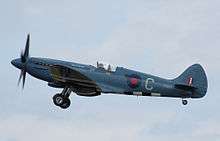 A Spitfire PR Mk 19, similar to those operated by No. 81 Squadron RAF from RAF Seletar.
A Spitfire PR Mk 19, similar to those operated by No. 81 Squadron RAF from RAF Seletar. The viewing gallery of Singapore Youth Flying Club overlooking the runway of Seletar. Note the club's Piper Warrior taxiing on the runway.
The viewing gallery of Singapore Youth Flying Club overlooking the runway of Seletar. Note the club's Piper Warrior taxiing on the runway.
Ground transportation
Bus
Two bus services (services 103 and 117) are available from the old airport terminal. Since 14 October 2018, Service 102 also serves the new airport terminal of Seletar Airport, with a new bus stop within the Passenger Terminal Building.[77] Service 102 allows access to the North East MRT line via Sengkang, Buangkok and Hougang stations.
Passengers heading to Changi Airport can alight at Jalan Kayu roundabout and transfer to 858. Connections to Tampines, Pasir Ris & Serangoon via services 168, 39 and 103 are also possible here. Passengers heading to Yishun (North South MRT line) may transfer to service 103 at Aft Baker St bus stop.
Taxi
Taxis are available at the taxi stands at the arrival hall. There is an additional airport surcharge for all trips originating from the airport.
See also
References
- Notes
- Shores et al. 1992, p. 146.
- Jefford 2001, pp. 48–49.
- "New Zealand Military Aircraft Serial Numbers – Short Singapore Mk III". adf-serials.com.
- Rawlings 1969, p. 242.
- "Our Expertise". Changiairportgroup.com. Retrieved 3 March 2017.
- "Our Story". Changiairportgroup.com.sg. Archived from the original on 26 November 2015. Retrieved 3 March 2017.
- "Extension of Seletar Airport runway completed". Civil Aviation Authority of Singapore. Government of Singapore. 14 September 2011. Retrieved 3 December 2019.
- "Expansion Plans for Singapore Airport". Airliner World: 14. February 2015.
- "Seletar Airport commences operations at new passenger terminal". changiairport.com. Retrieved 19 November 2018.
- "New Passenger Terminal Building to Be Constructed at Seletar Airport to Support Aviation Growth". Civil Aviation Authority of Singapore (CAAS). 19 May 2016.
- "New Passenger Terminal Building To Be Constructed at Seletar Airport To Support Aviation Growth". Changi Airport Group. 19 May 2016.
- "New passenger terminal building at Seletar Airport in the works". Channel NewsAsia. 19 May 2016.
- "New Control Tower at Seletar Airport is Latest Facility for Supporting the Seletar Aerospace Park and Business Aviation". www.caas.gov.sg. 10 January 2012. Retrieved 23 December 2018.
- Toh, Mavis (5 December 2018). "Singapore rebuts Malaysia's objection to ILS at Seletar airport". Flightglobal.com. Retrieved 25 December 2018.
- Hashim, Firdaus (23 November 2018). "Firefly cleared to operate Seletar flights: Changi Airport Group". Flightglobal.com.
- Kirat (17 January 2017). "A GLANCE AT IGNATIUS ONG, CEO OF FIREFLY AIRLINES". The Peak Malaysia. Retrieved 25 December 2018.
- "Malaysia's Firefly Aims To Increase Services To Singapore". Smart Aviation Asia-Pacific. 21 November 2017. Retrieved 23 December 2018.
- 5 Feb; ShowNews, 2018 John Morris |. "Seletar Airport Prepares for Turboprop Service". aviationweek.com. Retrieved 23 December 2018.
- Hashim, Firdaus (22 November 2018). "Firefly to suspend Singapore flights on airport move issues". Flightglobal.com. Retrieved 23 December 2018.
- Feng, Bree; Wong, Edward (10 March 2014). "Frustration Over Malaysian Flight Turns to Anger". The New York Times. ISSN 0362-4331. Retrieved 25 December 2018.
- The Star. "Family Members Get Some Answers from MAS Reps".
- "Missing MAS flight: MAS team arrives in Beijing - Nation | The Star Online". www.thestar.com.my. Retrieved 25 December 2018.
- migration (9 March 2014). "Missing Malaysia Airlines plane: MAS tells relatives of MH370 passengers in China to "expect the worst"". The Straits Times. Retrieved 25 December 2018.
- Straits Times (4 December 2018). "MOT releases documents on consultations with Malaysia on proposed new flight paths over Seletar Airport". The Straits Times. Retrieved 23 December 2018.
- "Singapore, Malaysia airspace dispute: What we know and timeline". Channel NewsAsia. Retrieved 23 December 2018.
- Hashim, Firdaus (26 November 2018). "Malaysia links airspace issues to Firefly's Seletar hold-up". Flightglobal.com. Retrieved 25 December 2018.
- November 2018, Published 1 month ago on 22. "Firefly to suspend all flights into Singapore from 1 December | Malay Mail". www.malaymail.com. Retrieved 23 December 2018.
- "Firefly suspends flights to Singapore, shocked passengers in lurch". www.nst.com.my. 23 November 2018. Retrieved 23 December 2018.
- "Loke's call to Singapore over disputed Seletar Airport landing approach". The Edge Markets. 12 December 2018. Retrieved 23 December 2018.
- "Anthony Loke Siew Fook". www.facebook.com. Retrieved 23 December 2018.
- "Malaysia's Civil Aviation Authority 'willing to work' with Singapore to resolve suspension of Firefly flights to Changi". The Edge Markets. 23 November 2018. Retrieved 23 December 2018.
- "Firefly's request to operate in S'pore's Seletar denied". Malaysiakini. 24 November 2018. Retrieved 23 December 2018.
- Zainul Fuad Md Wahi, Civil Aviation Authority of Malaysia. "Airport Standards". images.google.com. Retrieved 25 December 2018.
- Key Officers | Airport Standards, Zainul Fuad Md Wahi. "Civil Aviation Authority of Malaysia". www.dca.gov.my. Retrieved 25 December 2018.
- CAAS. "Seletar Airport - Implementation of ILS and ILS Approach Procedure for runway 21" (PDF). www.caas.gov.sg. Retrieved 25 December 2018.
- CAAS (1 December 2018). "Seletar Airport ILS" (PDF). www.caas.gov.sg. Retrieved 25 December 2018.
- "Seletar Airport Prepares for Turboprop Service". aviationweek.com. Retrieved 5 February 2018.
- "Singapore 2018: Seletar Airport set for turboprop move - Air & Cosmos - International". Air & Cosmos - International. Retrieved 6 February 2018.
- TeamAirsoc. "BERJAYA AIR RESUMES FLIGHTS TO REDANG AND SELETAR ON 1 FEBRUARY 2019 | Article - Wed 17 October 2018 03:44:00 PM UTC | airsoc.com. on airsoc.com". Airsoc.com. Retrieved 23 December 2018.
- "Malaysia's Berjaya seeks to boost its resort business by resurrecting an airline – Blue Swan Daily". Retrieved 23 December 2018.
- "Singapore Seletar Airport: new terminal offers niche alternative". CAPA - Centre for Aviation. Retrieved 23 December 2018.
- "Berjaya Air resumes flights to Redang and Seletar on 1 February 2019". Retrieved 23 December 2018.
- hermesauto (4 December 2018). "MOT releases documents on consultations with Malaysia on proposed new flight paths over Seletar Airport". The Straits Times. Retrieved 23 December 2018.
- "'Useful for negotiations' over Seletar Airport issue to be kept confidential: MOT". Channel NewsAsia. Retrieved 23 December 2018.
- the Star. "Loke: We're against ILS by Seletar Airport - Nation | The Star Online". www.thestar.com.my. Retrieved 25 December 2018.
- "MOT releases documents on consultations with Malaysia on proposed new flight paths over Seletar Airport". The Straits Times. 4 December 2018. Retrieved 23 December 2018.
- hermesauto (10 December 2018). "Singapore Transport Ministry responds to statement by Malaysia counterpart on Seletar Airport flight procedures". The Straits Times. Retrieved 23 December 2018.
- Bedi, Rashvinjeet S. "Transport Ministry: Singapore being 'selective' when disclosing information about ILS - Nation | The Star Online". www.thestar.com.my. Retrieved 23 December 2018.
- "Singapore rebuts Malaysia's statement over Seletar Airport flight procedures - Nation | The Star Online". www.thestar.com.my. Retrieved 23 December 2018.
- "Release the other letters or we will, Loke tells 'selective' S'pore MOT". Malaysiakini. 10 December 2018. Retrieved 23 December 2018.
- Lim, Ida. "Citing confidentiality, Singapore says only released relevant info on Seletar navigation system | Malay Mail". www.malaymail.com. Retrieved 23 December 2018.
- "MOT calls on Malaysian counterparts to release 'all correspondence' on Seletar Airport issue". TODAYonline. Retrieved 25 December 2018.
- "Transport Ministry says no to Singapore's suggestion to publish discussions on airspace dispute - Nation | The Star Online". www.thestar.com.my. Retrieved 23 December 2018.
- "ILS - Runway 03 The Answer". www.nst.com.my. 12 December 2018. Retrieved 23 December 2018.
- Shannon Teo, Adrian Lim (4 December 2018). "Singapore makes its point after Malaysia says it wants to take back management of airspace over south Johor". The Straits Times. Retrieved 26 December 2018.
- hermesauto (4 December 2018). "Singapore makes its point after Malaysia says it wants to take back management of airspace over south Johor". The Straits Times. Retrieved 25 December 2018.
- Post, The Jakarta. "Indonesia not ready to take over airspace from Singapore". The Jakarta Post.
- Decker, Barry. "Safety First in Managing Airspace" (PDF). Retrieved 25 December 2018.
- hermes (21 March 2016). "A strange anomaly in management of airspace". The Straits Times.
- Denmark Air Traffic Control, Danish AOR. "Copenhagen FIR". www.google.com. Retrieved 25 December 2018.
- The Sun Daily, Malaysia objects to use of ILS at Seletar airport, retrieved 25 December 2018
- "Singapore Ministry of Transport Statement in Response to Media Queries on Malaysia Ministry of Transport's Statement of 12 December 2018 on the Instrument Landing System (ILS) Procedures for Seletar Airport". www.mot.gov.sg. Retrieved 25 December 2018.
- hermes (13 December 2018). "New landing system for Seletar Airport doesn't impose new height restrictions: Experts". The Straits Times. Retrieved 23 December 2018.
- "Malaysia objects to use of ILS at Seletar airport (Video)". www.thesundaily.my. Retrieved 25 December 2018.
- New Straits Times (12 December 2018). "Loke explains why Malaysia against Singapore's ILS". www.nst.com.my. Retrieved 25 December 2018.
- hermes (13 December 2018). "New landing system for Seletar Airport doesn't impose new height restrictions: Experts". The Straits Times. Retrieved 25 December 2018.
- CAAS (1 December 2018). "Seletar Airport---implementation of ILS and ILS approach procedure for runway 21" (PDF). www.caas.gov.sg. Retrieved 25 December 2018.
- "SELETAR AIRPORT - IMPLEMENTATION OF INSTRUMENT LANDING SYSTEM (ILS) AND ILS APPROACH PROCEDURE FOR RUNWAY 21" (PDF).
- "CAAS' Approach to ATM Approach Approach to ATM Modernisation" (PDF).
- CAAS. "Seamless ATM" (PDF). Retrieved 25 December 2018.
- "News for Airlines, Airports and the Aviation Industry | CAPA". centreforaviation.com.
- Jr, Joseph Kaos. "Loke: Enough said about ILS, allow room for experts to settle dispute - Nation | The Star Online". www.thestar.com.my. Retrieved 25 December 2018.
- "Singapore seeks meeting with Malaysia on 'Restricted Area' over Pasir Gudang". The Star Online. 1 January 2019.
- "Singapore proposes to meet with Malaysia on Restricted Area". The Edge Markets. 1 January 2019.
- "Malaysia and Singapore resolve airspace issue, Firefly to resume flights to Seletar airport". The Star Online. 6 April 2019.
- "Malaysian carrier Firefly to resume Singapore flights with twice-daily trips". CNA.
- "SBS Transit Bus Schedule" (PDF). www.sbstransit.com.sg. Retrieved 23 December 2018.
- Bibliography
- Wing Commander C. G. Jefford (2001). RAF Squadrons: A Comprehensive Record of the Movement and Equipment of All RAF Squadrons and Their Antecedents Since 1912. Shrewsbury, Shropshire, UK: Airlife Publishing, 1988. ISBN 978-1-84037-141-3.
- Rawlings, J.D.R. "History of 230 Squadron". Air Pictorial, July 1969. Vol. 31 No.7. pp. 242–244.
- Shores, Christopher, Brian Cull and Yasuho Izawa. Bloody Shambles: Volume One: The Drift to War to the Fall of Singapore. London: Grub Street, 1992. ISBN 0-948817-50-X.
External links
| Wikimedia Commons has media related to Seletar Airport. |
- Seletar Airport at Changi Airport Group
- History of RAF
- Crest badge and Information of RAF Seletar
- RAF Seletar Association
- Review of book: "SELETAR, Crowning Glory – The History of the RAF in Singapore"
- History of 103 Squadron RAF 1917 - 1975
- Airport information for WSSL at World Aero Data. Data current as of October 2006.
.svg.png)

